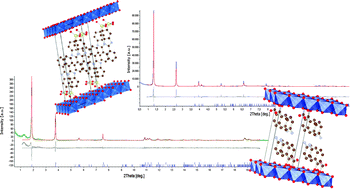Structural characterization and thermal and chemical stability of bioactive molecule–hydrotalcite (LDH) nanocomposites†
Abstract
Layered double hydroxides (LDH) are versatile materials used for intercalating bioactive molecules, both in pharmaceutical and cosmetic fields, with the purpose of protecting them from degradation, enhancing their water solubility to increase bioavailability, and/or obtaining modified release properties. The properties of the intercalation compounds of Mg/Al_LDH and Zn/Al_LDH with different drugs and sunscreens, namely diclofenac, ketoprofen, gliclazide, retinoic acid, furosemide, para-aminobenzoic acid and 2-phenylbenzimidazolsulfonic (Eusolex) acid, have been studied by crystallographic, spectroscopic and thermogravimetric techniques and by solid state NMR, to shed light on their structure, their molecular interactions and their stability from the thermal and chemical viewpoint. The structural features were described with particular attention to the interaction between the organic and inorganic components and to the stability of the intercalation products. For the first time two synchrotron radiation powder diffraction patterns of organic-containing LDH were solved and refined by Rietveld methods to obtain an experimental crystal structure.

- This article is part of the themed collection: Physical chemistry at the cross-road of advanced oxide materials

 Please wait while we load your content...
Please wait while we load your content...